The question of how to choose running shoes always pops up in our mind whenever we want to sideline the old ones and welcome the new pair in. It is always tricky to find that right pair that lasts for long and suits your style of running while keeping you off injuries. It’s important to understand some basic aspect such as pronation, looking at your running style and understanding what features works best for you. Having the right pair of shoes will help you to run faster, longer and most importantly, injury free.
Lets understand pronation
To simply put, pronation is how your foot lands on the surface. It is the motion of your foot from the hill to your toe as the foot strikes the surface. It is the way the foot rolls inwards when we take strides. Some people pronate more or less than others. It is important to pick up running shoes based on the type of pronation that you have.
You could do a simple test to determine your pronation type. Easiest way is to look at your old pair of shoe that you have been using until now. Depending on which side of the shoes shows wear and tear, you can determine how you pronate. Other easier way is to soak your foot in coloured water and than taking the imprint on a white paper or floor. Depending on what you see you know how you pronate.
Source
Type of pronation:
Neutral – Neutral pronation happens while you run or walk, you are striking the floor on your heel, then when you roll towards the toes, your arch lightly collapse inward absorbing the impact.
Underpronation (Supination) – It is the opposite of pronation and is refers to the outward roll of the foot during normal motion.
Overpronation –This means that the arch of your foot stretches inward too much, not assorbing the shock correctly and exposing you to injuries.
Most brands make shoes that offer different levels of support, according to your gait. This takes into account your footstrike – how your foot lands each time it hits the ground – and how you pronate. If you have high arches and your foot doesn’t collapse in or roll out as you run, you will be recommended a neutral shoe. If you have mild overpronation, you will be recommended a stability shoe. If you have a more severe overpronation, a motion-control shoe will be relevant to you for maximum stability.
Most of the popular shoe brands like Asics, trains their staff are to look at how your foot stirkes the ground. They make you run on the treadmill and record a video and are able to determine how your foot rolls and accordingly suggest a shoe.
My type of running
Once you have figured out your pronation type, its important to assess the type of running you will do. Most of the shoes are made for running on streets, pavement, treadmill or park. They are cushioned properly to protect your foot from the impact of running on the hard surfaces. Almost all of popular brands are offering these shoes which are well cushioned and the material used makes them very light. But if you are planning to run or uneven ground or participating in a obstacle race/ trail run, then trail shoes are a better option. Trail running shoes are designed for better grip/friction and are made strong to protect the foot.
How much to spend on the shoe
It’s a myth that more the price of shoe, the better it is. Its not necessary to go for most expensive shoe thinking that they offer more than the others. You can get a decent pair of shoe starting from Rs. 1500 or USD 25 onwards. Its important to make sure you find the right shoes as per how you pronate before considering the cost factor. If your budget allows, you can go for expensive pair of shoes as there is no upward limit.






